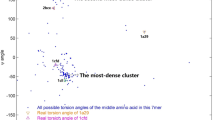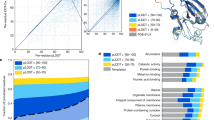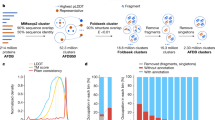Abstract
Various methods for the prediction of secondary structure from amino acid sequence can consistently achieve on average 60% accuracy when tested for several proteins1–3. Improvement on this value has proved difficult, despite increasing the size of the data set and refining predictive techniques4. The difficulty almost certainly derives from the influence of long-range interactions and the restrictions required to attain favourable protein topologies. We describe here a novel approach to structure prediction from amino acid sequence based on the recognition of super-secondary structure. The structure we initially consider is the βαβ unit, which consists of two parallel β-strands connected by an α-helix. From an analysis of all known βαβ units, an ideal secondary structure sequence was derived. This was used as a template to locate probable βαβ sequences in a standard secondary structure prediction. The method correctly predicted the location of 70% of the βαβ units in 16 β/α type proteins. This led to a 7.5% average improvement over the original secondary structure prediction.
This is a preview of subscription content, access via your institution
Access options
Subscribe to this journal
Receive 51 print issues and online access
$199.00 per year
only $3.90 per issue
Buy this article
- Purchase on Springer Link
- Instant access to full article PDF
Prices may be subject to local taxes which are calculated during checkout
Similar content being viewed by others
References
Chou, P. Y. & Fasman, G. D. Biochemistry 13, 211–245 (1974).
Garnier, J., Osguthorpe, D. J. & Robson, B. J. molec. Biol. 120, 97–120 (1978).
Schulz, G. E. & Schirmer, R. H. Principles of Protein Structure (Springer, Berlin, 1979).
Palau, J., Argos, P. & Puigdomenech, P. Int. J. Peptide Protein Res. 19, 394–401 (1982).
Busseta, B. & Hospital, M. Biochim. biophys. Acta 701, 111–118 (1982).
Bernstein, F. C. et al. J. molec. Biol. 112, 535–542 (1977).
Cohen, F. E., Sternberg, M. J. E. & Taylor, W. R. J. molec. Biol. 156, 821–862 (1982).
Matthews, B. W. Biochim. biophys. Acta 405, 442–451 (1980).
Brahms, S. & Brahms, J. J. molec. Biol. 138, 149–178 (1980).
Williams, R. W. & Dunker, A. K. J. molec. Biol. 152, 783–831 (1981).
Rao, S. T. & Rossmann, M. G. J. molec. Biol. 76, 241–256 (1973).
Richardson, J. S. Nature 268, 495–500 (1977).
Author information
Authors and Affiliations
Rights and permissions
About this article
Cite this article
Taylor, W., Thornton, J. Prediction of super-secondary structure in proteins. Nature 301, 540–542 (1983). https://doi.org/10.1038/301540a0
Received:
Accepted:
Issue Date:
DOI: https://doi.org/10.1038/301540a0
This article is cited by
-
A Hybrid Genetic-Neural System for Predicting Protein Secondary Structure
BMC Bioinformatics (2005)
-
Protein fold recognition
Journal of Computer-Aided Molecular Design (1993)
-
Structural domains of phytochrome deduced from homologies in amino acid sequences
Journal of Protein Chemistry (1992)
Comments
By submitting a comment you agree to abide by our Terms and Community Guidelines. If you find something abusive or that does not comply with our terms or guidelines please flag it as inappropriate.



